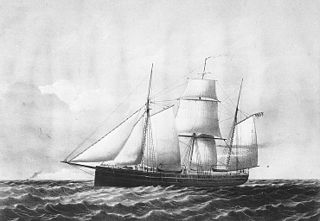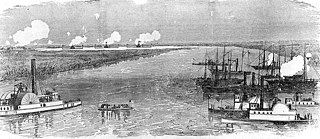
CSSEllis was a gunboat in the Confederate States Navy and the United States Navy during the American Civil War. It was lost during a raid while under command of famed Navy officer Lieutenant William B. Cushing.

The first USS Sassacus, a wooden, double-ended, sidewheel steamer in commission in the United States Navy from 1863 to 1865. She saw service in the American Civil War.

USS South Carolina was a steamer used by the Union Navy during the American Civil War.

USS Stars and Stripes was a 407-ton steamer acquired by the U.S. Navy and put to use by the Union during the American Civil War.

The first USS Monticello was a wooden screw-steamer in the Union Navy during the American Civil War. She was named for the home of Thomas Jefferson. She was briefly named Star in May 1861.

USS Niphon was a steam operated vessel acquired by the Union Navy during the American Civil War. She was used by the Navy to patrol navigable waterways of the Confederacy to prevent the South from trading with other countries.

USS Albatross was a screw steamer rigged as a three-masted schooner acquired by the Union Navy during the beginning of the American Civil War. She was outfitted as a gunboat with heavy guns and used in the Union blockade of the waterways of the Confederate States of America.
USS Henry Janes was a mortar schooner acquired by the United States Navy during the American Civil War. She was used as a gunboat and assigned to the blockade of ports of the Confederate States of America.

The first USS Mount Vernon was a wooden-screw steamer in the United States Navy.

USS Wilderness was a wooden-hulled, side-wheel steamship in the United States Navy during the American Civil War. After the war, she served as a revenue cutter. In 1873, she was renamed John A. Dix for former Secretary of the Treasury John Adams Dix.

USS Agawam was a double-ended, side-wheel gunboat of the United States Navy that served during the American Civil War. She measured 974 tons, with powerful rifled guns and a very fast speed of 11 kn. She served the Union Navy in the Union blockade of the rivers and other waterways of the Confederate States of America.

USS Unadilla was a Unadilla-class gunboat built for service with the United States Navy during the American Civil War. She was the lead ship in her class.

USS Aries was an 820-ton iron screw steamer built at Sunderland, England, during 1861–1862, intended for employment as a blockade runner during the American Civil War. She was captured by Union Navy forces during the Union blockade of the Confederate States of America, and was commissioned as a Union gunboat. Aries was named for the constellation.
USS Shawsheen was a steam operated tugboat acquired by the Union Navy during the American Civil War.

USS Hetzel was a steamer acquired by the Union Navy during the American Civil War. She was used by the Navy to patrol navigable waterways of the Confederacy to prevent the South from trading with other countries.

CSS Fanny was a small propeller-driven steam tug used by the Confederate States Navy to defend the sounds of northeastern North Carolina in the American Civil War. Originally armed as a gunboat and operated by the Union, she was captured in October 1861 by the Confederate Navy, and later lost at the Battle of Elizabeth City in February 1862. Due to being used as an observation balloon platform, Fanny is sometimes credited with being the first self-propelled aircraft carrier.

USS Para was a schooner acquired by the Union Navy during the American Civil War. She was used by the Navy to patrol navigable waterways of the Confederacy to prevent the South from trading with other countries.
USS Matthew Vassar was a schooner purchased by the Union Navy during the American Civil War. She was used by the Union Navy primarily as a mortar gunboat, but also as a gunboat stationed off Confederate ports to prevent their trading with foreign countries.
USS Britannia was a steamer captured by the Union Navy during the American Civil War. She was used by the Union Navy as a gunboat and patrol vessel in support of the Union Navy blockade of Confederate waterways.
The Battle of Cockle Creek, October 5, 1861, was a minor naval engagement off Chincoteague, Virginia early in the American Civil War.
















